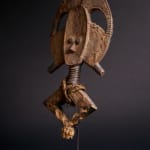Bakota Sculpture, 19th - 20th century
Wood
height 54.9 cm
height 21 5/8 in
height 21 5/8 in
MA.257
Further images
The Kota (or Bakota) people live in the East and Southeast of Gabon – a smaller proportion also cross the border into the Congo. The original religion of the Kota...
The Kota (or Bakota) people live in the East and Southeast of Gabon – a smaller proportion also cross the border into the Congo. The original religion of the Kota people was a distinct ancestor cult: previously the deceased lay out in the forest, subsequently they were buried in the earth. After some time the skulls of important clan founders and chieftains were excavated and, as a sort of ‘second funeral’, were placed in large baskets with other remembrance pieces. These baskets were sealed and preserved in special huts, or ‘sacred shrines’. If the village was moved, the baskets containing the bones of the ancestors accompanied the tribe to the new village, where they constructed a new, special ‘shrine’.
On each of these baskets containing the ancestor’s bones ‘sat’ a reliquary guardian figure, the ‘mbulu ngulu’ (‘reliquary basket with figure’). They were carved from wood and covered with brass plates or copper discs. The figures towered over each basket. The lower diamond shape reached into the vessel and was attached. The baskets were only brought out for important whole-village ceremonies. They were opened and their contents – the skulls of their ancestors – were presented, explained and ritually honoured. And so the venerated ancestors took part in the lives of their descendants. It is generally assumed that the ancestor cult of the Kota people, with its baskets and famous reliquary guardian figures, began in the 18th century and by roughly 1940 was extinct.
Towards the end of the 19th century the first reliquary guardian figures came to Europe and became some of the most coveted collectors’ pieces within the field of African art, which they still are today.
On each of these baskets containing the ancestor’s bones ‘sat’ a reliquary guardian figure, the ‘mbulu ngulu’ (‘reliquary basket with figure’). They were carved from wood and covered with brass plates or copper discs. The figures towered over each basket. The lower diamond shape reached into the vessel and was attached. The baskets were only brought out for important whole-village ceremonies. They were opened and their contents – the skulls of their ancestors – were presented, explained and ritually honoured. And so the venerated ancestors took part in the lives of their descendants. It is generally assumed that the ancestor cult of the Kota people, with its baskets and famous reliquary guardian figures, began in the 18th century and by roughly 1940 was extinct.
Towards the end of the 19th century the first reliquary guardian figures came to Europe and became some of the most coveted collectors’ pieces within the field of African art, which they still are today.







